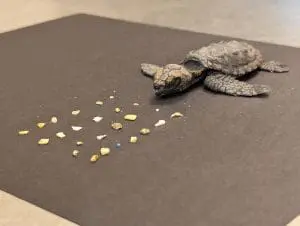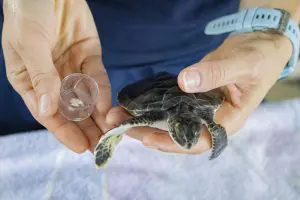

Belle has been doing well during her stay with us, but her recovery will be a long process.
Editor’s Note: This story contains an image of a young, deceased sea turtle.
Gingerbread weighed about as much as a carrot when the hawksbill sea turtle passed away with 24 pieces of plastic inside their body.
This young turtle came to us as a washback, a hatchling who has made it into the ocean but is swept back to shore – usually due to a big storm. We have dozens of these cases come through our Sea Turtle Healing Center every year, and the young turtles typically stay for a few weeks to get rehydrated after going through such a difficult life event. Gingerbread seemed like a straightforward case – they had no external injuries and had no need to be placed on antibiotics. However, when the young turtle passed away, we discovered the jagged pieces of plastic.

Gingerbread after their autopsy with the plastic they ingested.
Soon after Gingerbread passed, we had a similar patient. The second hawksbill turtle washback also passed away with 21 pieces of plastic ingested.
Healing Center coordinator Jess Patterson said she was not surprised to find the plastic when conducting the necropsies. Unfortunately, it has become extremely common for these young sea turtles to eat plastics floating amongst their seagrasses. In a study conducted by the Whitney Laboratory for Marine Bioscience, 92.86% of washbacks had plastic fragments in their GI tracts.
However, the amount of plastic Jess uncovered was what really shocked her. “It’s not uncommon to find 1 or 2 pieces, but to find this many was heartbreaking. And not just in one, but both hawksbills,” she said.
While we come across these sad cases, we also have resilient patients who we can help save. Belle, for

Belle pictured with some of the plastic that was removed from her cloaca.
example, is a juvenile green turtle who was found stranded with post-hatchlings. Like other washbacks, Belle came to us dehydrated and underweight. However, shortly into Belle’s stay with us, our team noticed several pieces of sharp plastic trapped in the turtle’s cloaca, an anatomical part in the rear of some animals that serves as a reproductive and lower GI opening. This created a very dangerous situation, as the plastic was creating a blockage, and she could not pass feces.
Our vet team acted quickly to remove all fourteen pieces of plastic. While Belle suffered some damage to the colon and cloaca due to the cutting edges of said plastic, the green sea turtle is now doing well. She has been treated with plenty of fluids to rehydrate, mineral oil to help with bowel movements and two types of antibiotics. We’re hopeful that Belle will recover from this ordeal and return to the ocean in the coming months.
Plastics and microplastics are often consumed by turtles of all ages, and they can cause serious injury and death, as seen by these three tragic cases. The longer plastic has been floating in the ocean, the more it begins to smell like their food sources. The algae and bacteria growth on all-sized plastics lead turtles to take what could be one of their last bites. We can all help protect these critical species in seemingly small ways that make big impacts:
- Next time you’re at the beach or a local park, do a quick pickup of all the plastics you see near you.
- Make sure you’re packing out everything you brought with you to the beach.
- Skip using single-use plastics like straws, bags or bottles.
Brevard Zoo is an independent, not-for-profit organization that receives no recurring government funding for our operating costs. Your generous support enables us to continue to serve our community and continue our vital animal wellness, education and conservation programs.
